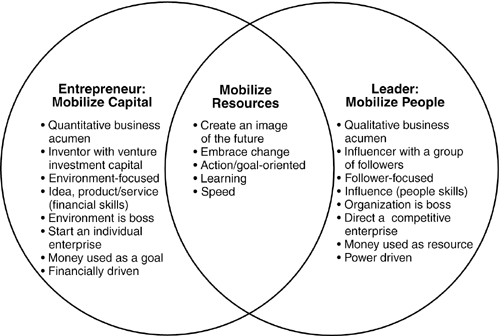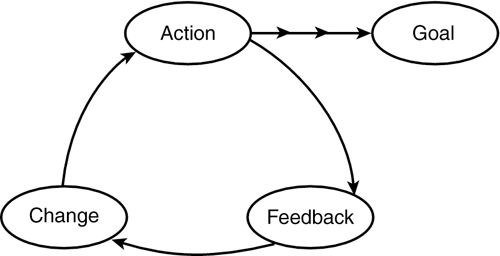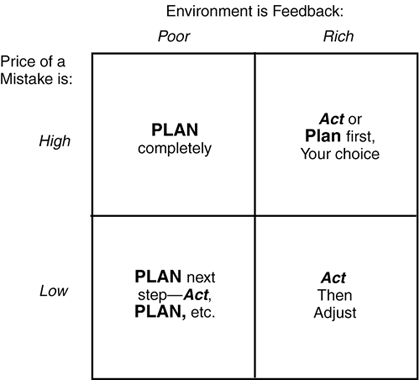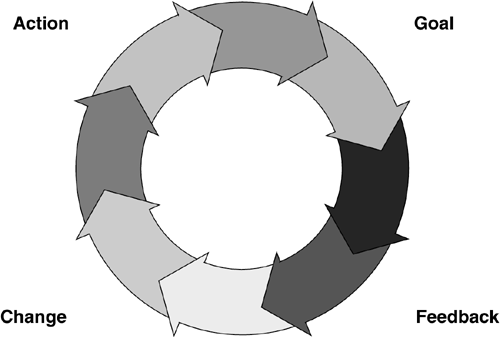Chapter 9. Entrepreneurial Leadership: Building Capacity for Speed, Risk, and Continuous Innovation
Joel R. DeLuca
This chapter proposes a working model[1] as a guiding approach and framework for placing significant issues related to the subject together and in perspective. The model was carefully crafted to be simple and powerful. It attempts to provide enough background to pinpoint a key emerging pattern of behavior common among those seen as successful entrepreneurial leaders. The purpose of this chapter is to stimulate thinking so that others can frame their own sense of entrepreneurial leadership.
Historical Background
The ancient Greeks had a word, pou sto, meaning a place to stand, a base, or a set of principles from which to operate. This chapter proposes one such pou sto for an area barely named, yet that is expanding wildly. It can act as a place to stand, reach out, capture, consolidate, and integrate the myriad of quickly converging trends related to entrepreneurial leadership. First, though, here is a bit of context.
If stages of civilization could be put in four words, those words might be seek, grow, make, know. Hunter-gatherers sought out their food, while farmers grew theirs; manufacturing made the machinery to grow food faster and make new products; now knowledge workers dominate the workplace. With the development of science, knowledge moved from incrementally additive to explosively exponential. Business is rising up this exponential slope with knowledge doubling at ever-faster rates, thus fueling the pace of change. Riding these waves of change has fundamentally altered the nature of business and leadership requirements.
Tribal leaders became kings of agricultural economies, who became captains of industrial economies, who are now becoming new breeds of leaders in information economies. Single-leader, chain-of-command pyramids operating 9 to 5 are transforming into multiple-leader, value-chain, virtual networks operating 24/7. Interaction between leaders, which for most of history was limited by the speed of a horse, has now moved to the speed of a photon (i.e., light). This is quickly shrinking the business planet to the anywhere, anytime global operation.
There have always been entrepreneurs and leaders. Previously, these roles have been examined as separate disciplines. However, the percentage of each needed in business populations of modern economies is shifting from minute to the majority, and skill convergence appears to be occurring. Sample evidence on each role contains surprises and similarities.
Entrepreneurship
The emergence of the entrepreneurial society may be a major turning point in history.
—Peter Drucker
What characterizes those at the forefront of this turning point? Mounting evidence indicates conventional wisdom contains many misconceptions:
- Learned trait: Entrepreneurs vary widely and do not seem to have an "inborn" trait guiding to success. Success seems more related to discipline and learned behaviors.
- Opportunity-focused: Successful entrepreneurs are not risk junkies or even risk-focused. Most are opportunity-focused people who have learned to manage risk well.
- Innovation: Core to most entrepreneurs is a drive for innovation that allows them to take advantage of the opportunities. Thus, entrepreneurs tend to embrace change rather than fear it, because they know change often creates the breeding grounds for opportunities.
- Continuous learning: Entrepreneurs make plenty of mistakes. What differentiates successful entrepreneurs is that they make mistakes based on calculated risks, so their batting average is high. They also learn quickly from mistakes. They avoid blame games and learn enough to turn mistakes into learning for future gain.
- Speed: Entrepreneurs move quickly to take advantage of opportunities before competitors do. There is enormous emphasis on speed of operation. Entrepreneurs have little patience for bureaucracy and low tolerance for cultural "sacred cows" that impede action. They are open to new ways of operating and quick to question past ways of doing things.
The skill set of entrepreneurs often includes other traits, such as the ability to mobilize capital, financial expertise, a quantitative mindset, and an improvisational spirit. Their boss is generally the environment rather than the hierarchy, and often they are profit-driven.
Leadership
Whenever the world changes so dramatically, what characterizes appropriate leadership also changes.
- —John Naisbitt, co-author of Megatrends
...As markets evolve, so does the definition of leadership.
- —Fortune Magazine
While initiative and inspiration remain, leadership too is an evolving concept. Next-generation leadership will likely include characteristics in tune with entrepreneurial needs of organizations. These include:
- Distributed leadership: Classical bosses are a dying breed. This trend may grate against the "too many chiefs, not enough Indians" belief, but in the future it is likely that everyone will be expected to contribute leadership.
The biggest change in leadership is our perception of who can be a leader. The response we heard over and over again is that everyone can be a leader.
—Rieva Lesonsky, Entrepreneur Magazine
The development of leadership in everyone is probably the single most important activity that any organization can be involved in. For the global business world, leadership is the competitive advantage.
—Stephen Covey, author of Seven Habits of Highly Successful People
- Vision: Setting the goals, direction, and strategic intent becomes even more important as it establishes the arena to seek opportunity.
Vision makes a true leader.
—Warren Bennis
A final theme in the new leadership definition is mastery over change.
—21st Century Leadership
- Continuous learning: Arguing against the notion "leaders are born, not made" is the evidence that future leadership depends upon the willingness to change behavior based upon learning.
Our research has shown that leadership skills are developed and replicated by people on the basis of experience—trial and error, doing it, getting the feedback, making mistakes, and doing it again. The first and most important way to be educated is trial and error, particularly in the most difficult situations.
—James Kouzes, President of Tom Peters Group/Learning Systems
[In a 20-year study of Harvard Business School graduates' success as leaders] I found that two elements stood out: competitive drive and lifelong learning.
—John Kotter, Ph.D., leadership researcher.
- Speed: A recent addition to leadership is valuing speed, as in first to market or faster cycle times.
The big won't beat the small, the fast will beat the slow.
—John Chambers, CEO, Cisco, Inc.
The Emerging Convergence of Two Ships
As dynamic markets begin to dominate, these two roles are becoming more similar. The hulls of the two ships—entrepreneurship and leadership—are rapidly evolving into a catamaran-like vessel of entrepreneurial leadership. A catamaran uses two hulls, connected by overlapping structures, to move much faster with the winds of change than either hull alone can move. Some of the classical stereotypes of each skill and areas of potential overlaps are illustrated in Figure 9.1.
Figure 9.1. Potential overlaps.

There is not widespread agreement on definitions of either leadership or entrepreneurship, which makes defining entrepreneurial leadership doubly difficult. However, there is a commonality. Both entrepreneurs and leaders have behaviors that mobilize resources. From this, we propose a working definition of entrepreneurial leadership: mobilizing resources to create and capture opportunities. This definition requires leaders who can build capacity for speed, risk, and continuous innovation.
Dynamic Stability: A Basis for Entrepreneurial Leadership
Dictionary definitions of stability include phrases such as "not changing or fluctuating; permanent; resisting forces tending to cause motion; develop forces to restore equilibrium of original condition." On the other hand, dictionary definitions of dynamic contain phrases such as "deals with forces and their relation primarily to motion; pattern of change; forces sometimes associated with equilibrium." While in many ways the definitions seem opposite, they overlap around the concept of equilibrium. Entrepreneurial leadership requires a model that generates a special form of equilibrium, based not on stability of content or structure, but on stability of process. Dynamic stability is based upon equilibrium produced by continuous, often relentless movement. An example is the gyroscope that guides terrain following aircraft moving at supersonic speeds. Another example is the bicycle. On a bicycle, the faster you go the more stable the bike is. When you slow down, you wobble. Dynamic stability represents a "next-generation" basis for a leadership model. It is a basis that seems to contain the countervailing forces appropriate to entrepreneurial leadership.
A Working Model of Entrepreneurial Leadership
The carefully developed working model pictured in Figure 9.2 resulted from a historical review of the evolution of leadership and entrepreneurship models of researchers and practitioners and after many interviews with those seen as successful leaders in entrepreneurial environments.
Figure 9.2. A working model of entrepreneurial leadership.

The words in the model serve as mere placeholders for entire leadership domains, each with its own complexities. By design the model is applicable to individual, team, and organizational levels. It is compatible with more cumbersome leadership, educational, change, entrepreneurial, and cybernetic models. It can be shown to fit with the scientific method. The model depicted might result from taking many existing models, stripping them down to their common core, souping up that core into a dynamic engine, and streamlining that engine by using basic business concepts.
The Potential Value of the Model as a Working Guide
The model is simple, deceptively so. While it appears simple, embedded in the model is much of the complexity intrinsic to entrepreneurial leadership. The model was crafted to attain a form of elegant simplicity that would bring some order to the wild diversity of entrepreneurial leadership. The overall result is a model easy to learn but difficult to master. Like the martial arts, the elements are already built into our brains and bodies. However, achieving black-belt level requires deeper understanding, discipline, and conscious practice.
The continuous-motion aspect of dynamic stability is represented by using a continuous learning cycle as the core engine that powers the model. In this sense, the model is as old as humanity and as modern as the 21st century. The model is old because the basic elements of trial-and-error learning are embedded (action = trial; error = negative feedback). It is modern because key leadership issues are shown in dynamic relation to one another. The model also connects the elements goal, action, feedback, and change in a step-by-step fashion, like a dance routine laid out in steps on the floor. Put in continuous motion, the sequence of steps become the jazz dance of entrepreneurial leadership, requiring spin, grace, agility, rhythm, and discipline. It is in the relationships that issues such as speed, risk, continuous innovation, and performance-building capacity become more apparent. Businesspeople already use various forms of goal, action, feedback, and change as well as trial-and-error learning everyday. A model that integrates these often disparate processes, along with other issues of entrepreneurial leadership (such as systems thinking, cycle time, innovation as part of change management, speed, distributed leadership), can make the complex set of links between them more understandable. It can also help leaders zero in on key leverage points to increase overall business success.
Key Counterintuitive Behaviors of Entrepreneurial Leaders
As markets become more dynamic, leadership evolves from building upon past practice, to envisioning the future, to developing a present discipline for rapidly evolving responses to opportunities. As a consequence, much of conventional wisdom is reversed in entrepreneurial leadership. Using the model as a guiding framework, a few such examples include

Goal:
Instead of goals as endpoints, use goals as starting points. Conventional wisdom would set the goal as the endpoint or destination. Yet, entrepreneurial leaders in dynamic environments often use goals as the starting point for the cycle of the model. The goal acts as a stake in the ground around which things move.

Action-Goals:
Instead of action following goal clarification, action precedes goal clarification. Conventional wisdom assumes that goals precede action. However, in dynamic environments, it is difficult to fully clarify goals. This situation produces ambiguity. In ambiguous situations people get stuck and don't act until they receive further clarity. Entrepreneurial leaders put the issue in a different frame and ask, "In an ambiguous situation, which comes first, clarity or action?" When framed this way, most people break out of the "waiting-for-clarity" deadlock that paralyzes many organizations. It is sometimes useful to act first in order to develop and clarify goals; thus the conventional wisdom of action following goals is reversed in this "chicken and egg" dilemma.

Action-Feedback:
Instead of action generating feedback, feedback generates action. Normally, feedback follows action in order to determine how well the action leads to the goal. However, in dynamic situations, the feedback structure actually affects both risk taking and speed of action. Figure 9.3 illustrates how the feedback structure affects action. The structure that works best is lots of feedback and low repercussions for hidden mistakes. This dynamic is a key skill of successful entrepreneurial leaders. They lower risk and accelerate initiative by finding ways to increase feedback and reduce the price of mistakes.
Figure 9.3. Plan-act matrix.


Feedback:
Instead of passively receiving feedback, actively solicit feedback. This is probably the fastest growing area in leadership and business. Stakeholder reviews, competitive benchmarking, 360° appraisal, and Internet search are just a few examples of actively soliciting feedback. Conventionally, feedback was simply information received regarding the results of an action. Entrepreneurial leaders see feedback as the fuel for innovation and speed of response. They build feedback into consumers and suppliers' systems. Realizing that feedback comes from the task, others, and oneself, entrepreneurial leaders are much more assertive and systematic in seeking out feedback.

Feedback-Change:
Instead of feedback to keep action on track, feedback is used to raise fundamental assumptions. Conventionally, feedback initiated change that modified action to keep it focused on the set goal. In entrepreneurial leadership, feedback is also used to raise fundamental assumptions. Questioning basic assumptions often leads to new ways of seeing markets, thus stimulating innovative responses. Leveraging this dynamic is critical to continuous innovation.

Change:
Instead of change focused on action, allow change to focus on goal, feedback, and change process. Traditional change focused on the action component, ensuring behavior was modified as needed to achieve the goal. In entrepreneurial leadership, change also focuses on the goal itself, in which a new vision and related goals may arise that could possibly change the business the organization is in. This would be a type of double-loop learning. Change might also focus on modifying the feedback component by adding customer and competitive feedback to historical benchmarks. This enriched feedback can fundamentally alter the meaning of success. The change process itself can be changed: for example, using the entire top team and/or adding succession-planning individuals into the change process. Action is just one aspect for change to address. Entrepreneurial leaders are more likely to use the full range of options.

Change-Action:
Instead of implementers involved after change decision, implementers involved before change decision. Historically, change decisions have been enacted by implementation through the hierarchy. Implementers enter the process after key decisions are made, and often at a slow, inefficient pace. Entrepreneurial leaders are more likely to value commitment than obedience. They often reverse the process and involve implementers prior to the decision, which can speed up change and help beat competitors to market.
Smart Moves
Entrepreneurial leaders integrate both conventional and unconventional wisdom. "Smart moves" demonstrate this integration in practice and embody the essence of the entrepreneurial leadership model. A smart move is more than a smart risk. A smart risk focuses on whether the action is worth taking. If costs outweigh benefits, action stops. Since a smart move is opportunity-focused rather than risk-focused, movement continues despite risk, but it is based on whether the opportunity is worth seeking. A smart move aggressively manages risk within the situation by integrating various leverage points in the model, such as breaking the action into (1) smaller, (2) faster, (3) low-cost, and (4) feedback-rich steps. Such steps can lower risks and speed learning. Faster learning leads to faster assumption raising, thus facilitating innovation and faster change to improve actions as well as faster discovery of new opportunity goals.
Smart moves are either successful or a good investment for future success or both. These moves integrate parts of the model and their relationships into the agile jazz dance of entrepreneurial leadership. When spun to full speed, continuous smart moves power up the model to the point of dynamic stability where the process can have a "buzz-saw" effect, taking on obstacles bit by bit but at such speeds that it can cut through them extremely rapidly. Entrepreneurial leaders grow their business by building this capacity for continuous smart moves. They set up their organizations to take quick, small, low-cost, feedback-rich steps by helping workers become experts in probing, prototyping, and piloting; using multiple trials with fast turnarounds; and creating highly enriched feedback environments involving multiple stakeholders, especially customers. They create climates of learning versus punishment. (See figure 9.4.)
Figure 9.4.

How the Business Playing Field Is Shifting
Entrepreneurial leadership, with its emphasis on smart moves, fundamentally alters the success landscape, as illustrated in figures 9.5 and 9.6. Historically, mistakes have equaled failure. Pressure for immediate performance overshadowed actions that built capacity by learning from mistakes. As a result, Figure 9.5 was more the norm. Entrepreneurial leaders recognize that if a mistake generates data and learning that rapidly increases performance capacity, then it could be seen as a "positive failure," something hard to imagine from a traditional performance mindset. Also in this new landscape there can be "negative successes." How can a success be negative? An example might be meeting performance targets by selling off the research and development function responsible for future innovations and profits. Getting the job done in ways that burn out top talent who then leave the company is another example. Mistakes from "smart moves" that generate valuable feedback are now a part of good entrepreneurial leadership behavior. In new, fast-changing markets, mistakes fuel the learning essential to building capacity to continually grow the business. Figure 9.6 is a better depiction of the shifting success landscape.
Figure 9.5. Performance capacity: old success zone.

Figure 9.6. Performance Capacity: new success zone.

Summary
Both leadership and entrepreneurship are evolving and rapidly converging. Organizational size matters little, as both the big and the small need these skills. In the past, a leader's confidence often came from knowing the answer, and thus avoiding mistakes. A major shift for future success in entrepreneurial leadership will not be from knowing the answer, for today's answer may last just until tomorrow's newspaper headline or Internet flash. The confidence of entrepreneurial leaders will come from knowing a dynamic, yet stable process for rapidly evolving an effective response to an opportunity even if the response will be of value for only a short while. They will then use their capacity to quickly mobilize resources into smart moves to evolve a new response. Powering this continuous learning process in a disciplined way can excite and ground organizations to more confidently act with the speed, risk, and continuous innovation that can create and capture new opportunities. Hopefully, such an approach can be a pou sto from which people have the confidence to dare.
